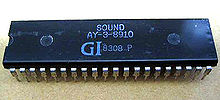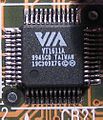Sound chip
A sound chip is an integrated circuit for sound generation and output in electronic musical instruments and computers . They contain at least one D / A converter and an interface to the rest of the system.
history
Sound chips were first used in arcade games in the late 1970s . The most famous sound chip of this time was probably the AY-3-8912 , which was later marketed as the YM2149.
In the 1980s, sound chips in home computers were the only way to reproduce music and sounds, as the technology of analog-digital conversion and sampling on 8-bit systems only allowed unsatisfactory results with relatively high resource consumption. In addition to the AY-3-8912 ( to be found in the Mattel Intellivision , Amstrad CPC and Atari ST, among others ), the SID in the C64 is the most famous sound chip. Other 8-bit sound chips that are interesting in terms of sound and are still used today in so-called micromusic can be found in the Nintendo Entertainment System ( 2A03 ), in the Super NES ( SPC700 ) and in the Game Boy . With the sound chips of that time, polyphonic melodies could already be played. Some made it possible to generate sounds as they were known from synthesizers .
From the beginning of the 1990s, sound chips for PCs on sound cards based on FM synthesis ( Yamaha YM3812 and successor, better known as OPL) were introduced. Without a sound chip, the sound could only be output via the system loudspeaker as a beep ( monophonic square-wave signal). In contrast, these chips could independently convert MIDI signals into sounds. The chips of that time were based heavily on the development of electronic music devices such as keyboards and synthesizers.
In addition to polyphonic sound synthesis , later sound chips also had their own memory as ROM (e.g. sample ROM) or RAM (to relieve the system memory) as well as their own processor to relieve the CPU and were able to initially save stored sounds in 8 -Bit, to be played later in 16-bit technology. The chips from the company E-mu were widespread, which , like samplers , could play any instruments based on a MIDI signal, which were combined in sound banks, so-called sound fonts . These cards were already used for commercial music productions.
With the advent of better PCs and the AC-97 standard, chips for PCs have been harmonized. These mostly contain integrated converters and mixers and increasingly do without audio synthesis in hardware. Instead, there are more and more functions for processing the sound at the WAV level. For applications in music devices, however, sound generation chips with MIDI functions are still used - especially for FM synthesis. These are often used in do-it-yourself projects. In addition, there are FM synthesis chips in programmable hardware and in virtual form for PC audio software as plugins and even freeware.
Modern sound chips with signal processor is called APU ( a udio p rocessing u nit) or audio CODEC .
technology
One can differentiate between different versions:
- Onboard sound chips: located directly on the motherboard and therefore inexpensive, connected via PCI
- Sound card: sound chip on plug-in card with additional components for subsequent expansion of the system
- Chips for external consumer sound devices for connection to systems that do not have expansion slots, connected via USB or FireWire
- Chips as manufacturer-specific special designs for electronic musical instruments
Examples
See also
literature
- Nils Dittbrenner: Sound chip music. Osnabrück: epOs-Music 2007, ISBN 978-3-923486-94-6
- Horst Zander: PC recording studio. Volume 6, Appendix 1, Soundchip-Musik, pp. 601–664 Berlin: M3C, ISBN 978-3-9809632-5-1
Web links
- Master's thesis on sound chips (PDF file; 714 kB)
Individual evidence
- ↑ SAM2695 Single Chip Synthesizer with Effects | Profusion. Retrieved July 17, 2020 .
- ↑ Fabian Günther-Borstel: OPL2 & OPL3, their clones and replicas. In: AmoRetro.de. 2017, accessed July 17, 2020 .
- ↑ Thorsten Klose: OPL3 chips. In: www.uCApps.de. February 16, 2020, accessed July 17, 2020 .
- ↑ Jürgen Schuhmacher: A FM-Synthesis Module in VHDL with 8 operators - JS 2006. 96KHZ, 2006, accessed on July 17, 2020 (English).
- ↑ Test: Yamaha Vintage Plug-In Collection, Steinberg. In: AMAZONA.de. January 2, 2012, accessed on July 17, 2020 (German).
- ↑ OPL by discoDSP - FM Synthesizer VST VST3 Audio Unit. Retrieved July 17, 2020 .
- ↑ Ben James: VST4FREE. Bruce Sutherland, 2020, accessed July 17, 2020 .






